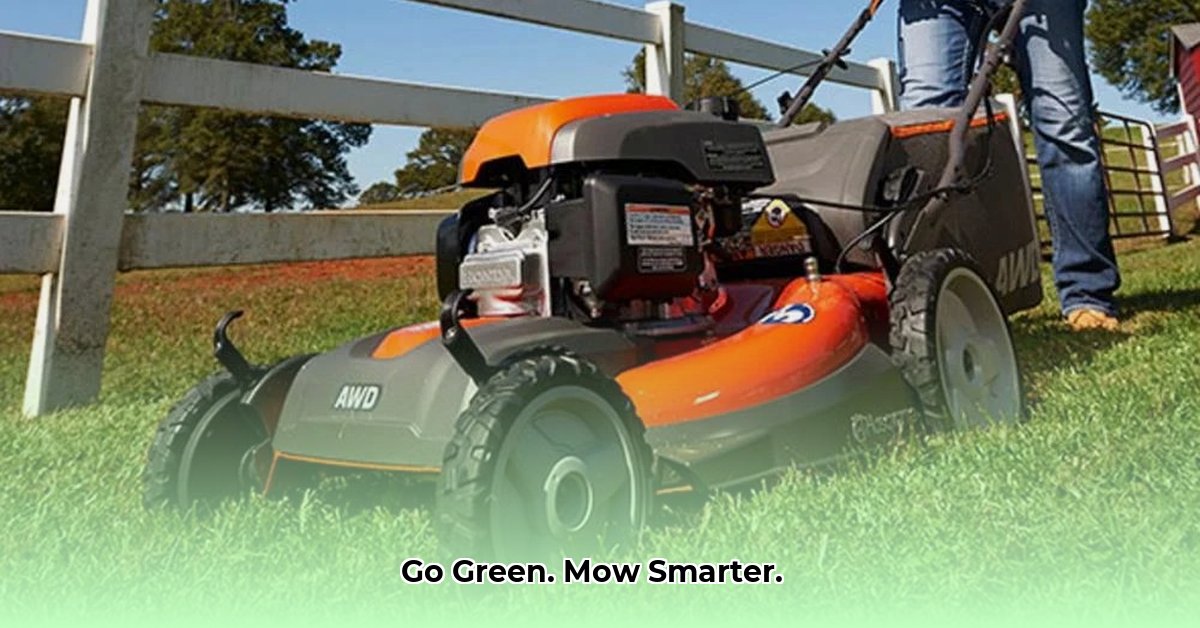
Self-Propelled Lawn Mowers: A Greener Approach to Yard Care?
Maintaining a lush lawn shouldn't come at the expense of the planet. This article explores the environmental implications of self-propelled lawn mowers, specifically those available from Tractor Supply, focusing on how to choose a model that minimizes your environmental footprint. We'll examine the advantages of self-propelled mowers, analyze their sustainability, and provide actionable steps for a greener lawn. For more on comparing yard tractors and garden tractors, see this helpful guide: Tractor Comparison.
The Advantages of Self-Propelled Mowers
Self-propelled mowers, particularly rear-wheel drive (RWD) models, offer significant advantages over manual push mowers, especially for larger yards or uneven terrain. They drastically reduce physical exertion, saving you time and energy. This increased efficiency translates into less time spent mowing—time that can be dedicated to more environmentally friendly activities such as gardening or tree planting. But how does this convenience translate to environmental benefits? That question forms the crux of this analysis.
Sustainability: A Critical Examination
While the efficiency gains are undeniable, a comprehensive assessment of the environmental impact of self-propelled mowers is crucial. Currently, readily available data on fuel consumption and emissions across various models remains limited, hindering a complete picture. Gas-powered mowers, for example, raise concerns about greenhouse gas emissions and air pollution. A thorough lifecycle assessment, encompassing manufacturing, use, and disposal, is necessary to fully understand their environmental footprint.
Isn't it concerning that we lack complete data on the environmental impact of such widely-used products? This highlights the urgent need for further research in this area. The convenience of these mowers might lead to more frequent mowing, potentially negating some efficiency gains. Furthermore, noise pollution from gas-powered models remains a significant concern, impacting local ecosystems and human well-being.
Comparing Mowing Methods: A Sustainability Matrix
To provide context, let's compare self-propelled mowers to other options:
| Mowing Method | Pros | Cons | Sustainability Considerations |
|---|---|---|---|
| Manual Push Mower | Zero emissions during use; low cost | Physically demanding; impractical for large areas or uneven terrain | Ideal for small, flat yards; minimizes direct carbon footprint. |
| Self-Propelled (Gas) | Efficient; easier on larger lawns; readily available | Greenhouse gas emissions; noise pollution; fuel leaks and spills potential | Prioritize fuel-efficient models; consider mulching to reduce fertilizer use. |
| Self-Propelled (Electric) | Zero direct emissions during operation; quieter operation | Higher initial cost; limited runtime; charging time required | Evaluate battery life and charging infrastructure; consider battery production and disposal. |
| Robotic Mower | Automated; quiet operation; convenient | High initial cost; may not handle inclines or complex terrain; battery concerns | Assess energy consumption; consider end-of-life battery recycling. |
Actionable Steps Towards Greener Lawns
Improving lawn care sustainability requires a multi-pronged approach:
For Homeowners:
- Research Fuel Efficiency: Thoroughly research the fuel efficiency (for gas models) or battery life (for electric models) of different mowers before purchasing.
- Prioritize Electric Options: Electric mowers significantly reduce emissions. If your yard size and budget allow, prioritize this option.
- Embrace Mulching: Mulching grass clippings reduces the need for chemical fertilizers, improving soil health and reducing environmental impact.
- Practice Responsible Disposal: Properly recycle or dispose of your mower at the end of its life, following local guidelines.
For Manufacturers:
- Conduct Lifecycle Assessments: Perform comprehensive lifecycle assessments to identify areas for improvement across the entire product lifecycle.
- Invest in Electric Motor Technology: Increase R&D in quieter and more efficient electric motor technology.
- Design for Durability and Repairability: Create longer-lasting, easily repairable mowers to reduce waste.
- Explore Biofuel Compatibility: Investigate the potential of biofuels as a more sustainable alternative to gasoline.
For Regulatory Bodies:
- Implement Stricter Emission Standards: Set stricter emission and noise level standards for all lawn care equipment.
- Incentivize Sustainable Technologies: Provide tax credits or subsidies to encourage the adoption of eco-friendly mowers.
For Research Institutions:
- Conduct Comprehensive Impact Studies: Conduct in-depth studies on the environmental impact of lawn care, including noise and resource use.
- Investigate Societal Influences: Study the societal factors driving lawn care practices to inform policy changes and product development.
The Future of Green Lawns: A Shared Responsibility
Self-propelled mowers can contribute to a greener future, but this requires a joint effort from manufacturers, consumers, and policymakers. By making informed choices and prioritizing sustainable practices, we can collectively cultivate healthier lawns and a healthier planet.
Choosing the Right Sustainable Mower: A Practical Guide
Choosing a sustainable self-propelled RWD lawnmower involves considering various factors beyond the engine type.
Gas vs. Electric: A Comparative Analysis
Electric Mowers: Offer zero tailpipe emissions during operation, quieter operation, and often simpler maintenance. However, battery life and higher initial costs can be limiting factors.
Gas Mowers: Provide longer runtimes and greater power, but generate emissions and require more maintenance.
The best choice depends on individual needs and priorities. Larger lawns or those with significant inclines might benefit from a gas-powered model, while smaller, flatter yards might be ideally suited to an electric mower.
Beyond the Engine: Enhancing Sustainability
- Mulching Capabilities: A mulching deck recycles grass clippings, reducing fertilizer needs.
- Cutting Height Adjustment: Allows for healthier lawn growth, reducing stress on the grass.
- Responsible Disposal: Proper disposal of old mowers and batteries is crucial for minimizing environmental harm.
- Efficient Mowing Practices: Overlapping mowing passes ensures even cutting, reducing the number of passes and conserving energy.
Actionable Steps for Sustainable Lawn Care
- Assess Your Needs: Consider lawn size, terrain, and budget.
- Research Models: Compare models from Tractor Supply, focusing on features like runtime, mulching, and noise levels.
- Prioritize Efficiency: Look for features that enhance efficiency, such as larger deck sizes and effective mulching systems.
- Consider Lifecycle Costs: Factor in fuel or battery replacement costs over the mower's lifespan.
- Make an Informed Decision: Choose a mower that balances your environmental concerns with your personal needs.